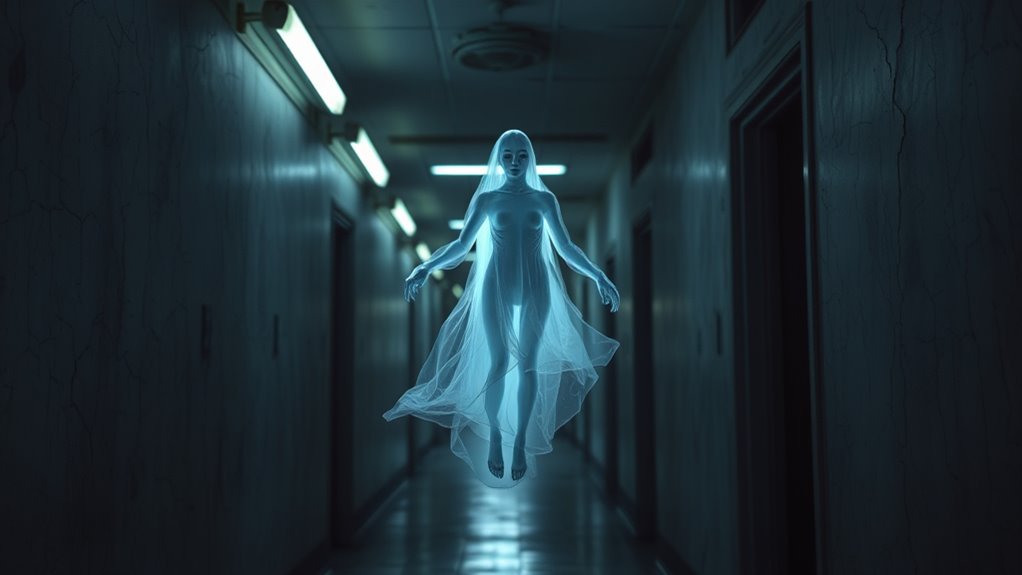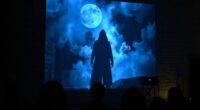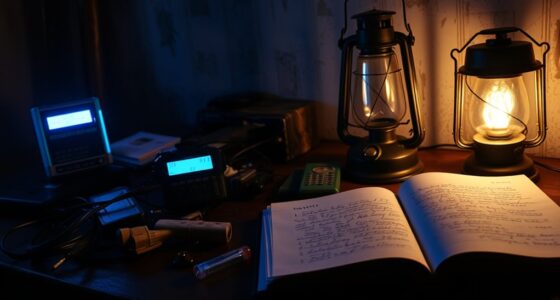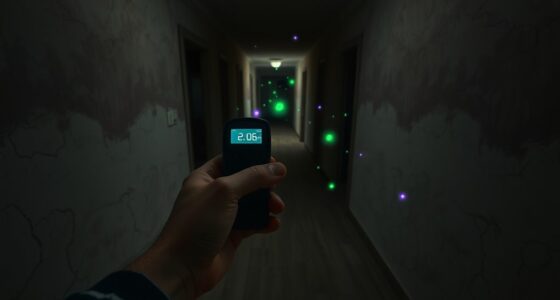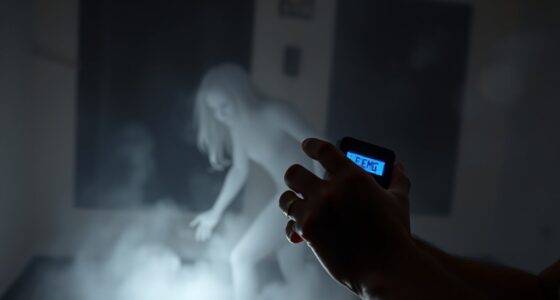When capturing ghosts on camera, you must understand how different lighting and settings can create or obscure spectral images. Longer exposures can reveal faint figures invisible to the naked eye, but environmental factors like dust or reflections might produce false positives. Adjusting shutter speed, ISO, and angles can help you distinguish between genuine apparitions and camera artifacts. Keep an eye on light interactions—they often hold the key, and if you explore further, you’ll uncover more about these mysterious images.
Key Takeaways
- Longer exposure times can reveal faint spectral figures but may also increase noise and artifacts.
- Camera artifacts like lens flare or double exposure often mimic ghostly apparitions.
- Environmental factors such as dust, insects, or reflections can create false positives in ghost photography.
- Adjusting shutter speed and ISO settings enhances chances of capturing genuine or intriguing paranormal images.
- Analyzing light interactions and shadows can help differentiate real spirits from visual illusions or artifacts.
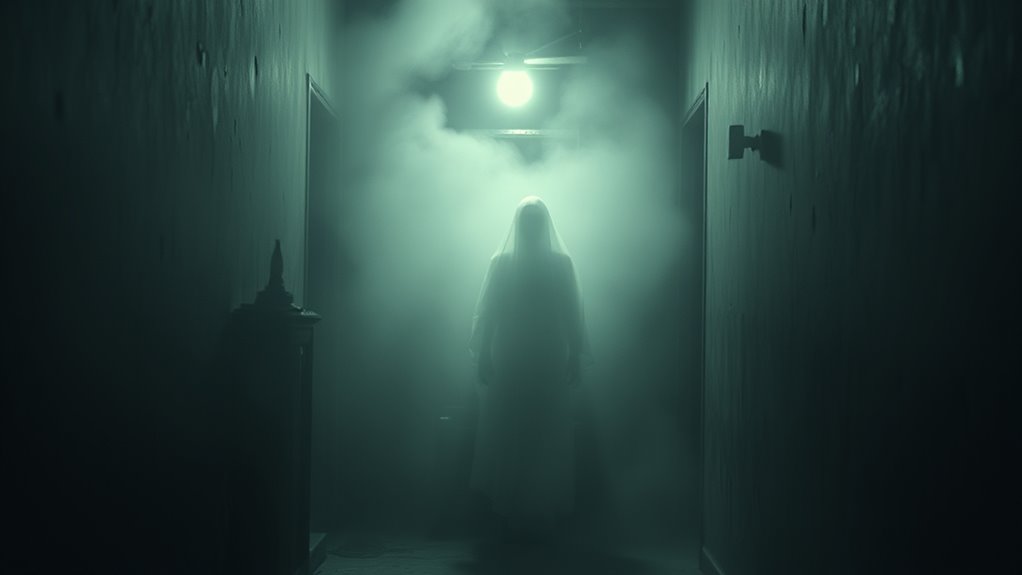
In a world where images can reveal hidden truths or conjure illusions, the line between photography and phantoms often blurs. When you set out to capture a ghostly apparition, your camera becomes a tool for both discovery and deception. Light exposure plays a vital role in this pursuit. Longer exposures can amplify faint, fleeting movements, making ghostly figures appear more prominently—or creating the illusion of one. You might leave your camera running in dimly lit environments, hoping that the right combination of light and time will reveal spectral presences. Yet, these same settings can also produce accidental artifacts—strange shapes or shadows that seem otherworldly but are just the result of camera quirks or environmental factors.
As you adjust your camera’s exposure, you might notice ghostly apparitions emerging unexpectedly. These ethereal images can be caused by a variety of factors. Sometimes, they’re simply the result of double exposures, lens flare, or reflections. Other times, the movement of dust particles or insects close to the lens, illuminated by a flash or ambient light, can create the illusion of a floating figure. It’s tempting to see spirits in every anomaly, but often, these are just tricks of the eye or the camera’s sensor. Recognizing camera artifacts can help distinguish between real and false images. Additionally, understanding photo manipulation techniques can further help in evaluating the authenticity of ghost images.
A deeper knowledge of sensor limitations and environmental influences can aid in identifying false positives and improving your detection skills. To increase your chances of capturing such phenomena, you might experiment with different shutter speeds and ISO settings. Short exposures tend to minimize noise and unwanted artifacts, but longer ones can reveal subtle movements and faint figures that are otherwise invisible to the naked eye. When you review your shots, pay close attention to areas of the frame where light has interacted strangely—these spots might hold clues to ghostly activity or, at the very least, intriguing visual effects. Sometimes, a slight change in your angle or timing can transform an ordinary scene into a haunting image, especially in environments where ambient light fluctuates or flickers. Using proper camera settings can further improve your chances of capturing authentic or intriguing images.
Ultimately, whether you’re chasing genuine spirits or merely chasing illusions, your camera becomes a vessel for exploration. Light exposure isn’t just a technical setting; it’s the gateway to revealing—or fabricating—the unseen. Every ghostly apparition caught on camera invites you to question what’s real. Are they spirits lingering in the shadows, or just artifacts created by the interplay of light, shadow, and technology? The truth remains elusive, but the pursuit of capturing the supernatural keeps your curiosity alive, pushing you to keep experimenting, keep believing, and keep believing that sometimes, the camera can unveil what the naked eye cannot see.
Frequently Asked Questions
Can Camera Settings Influence Ghostly Appearances in Photos?
Camera settings definitely influence how ghostly appearances show up in your photos. Adjusting exposure, ISO, and shutter speed can create eerie effects or highlight mysterious figures. Digital filters can enhance or distort these images, while lens flare might mimic ghostly lights or shapes. By experimenting with these settings, you can make ghostly figures more or less prominent, giving your photos a spooky or surreal vibe.
Are Certain Camera Models Better for Capturing Spirits?
You might wonder if certain camera models are better for capturing spirits. Generally, cameras with a high-quality lens and adjustable sensor sensitivity give you more control over image clarity and low-light performance. These features can help you capture elusive ghostly phenomena more effectively. Look for models that allow manual settings, so you can fine-tune your camera to enhance ghostly appearances and increase your chances of success.
How Do Lighting Conditions Affect Ghost Photography?
Lighting conditions play a pivotal role in ghost photography. You should avoid areas with light pollution, as artificial lights can obscure or distort ghost images. Additionally, atmospheric moisture can enhance or hinder your chances; high humidity may create fog or haze, adding a mysterious effect, but too much can cause blurred captures. For clearer shots, opt for low-light environments with minimal pollution and stable atmospheric conditions.
Is Post-Processing Responsible for Ghost Images?
Did you know that over 60% of claimed ghost images involve digital manipulation? Post-processing can be responsible for ghost images, especially through photographic artifacts or intentional edits. When you enhance or alter photos, you might create illusions of spirits or anomalies. Be cautious, as digital manipulation can easily produce misleading ghostly effects, making it essential to distinguish between genuine phenomena and edited images.
Can Everyday Objects Create Ghost-Like Illusions in Photos?
You might notice that everyday objects can create ghost-like illusions in photos. These object illusions happen when reflections, shadows, or motion blur interact with your camera’s settings, making ordinary artifacts appear eerie or transparent. To avoid confusion, check your scene carefully, consider changing angles, or adjust your focus. Recognizing how these everyday artifacts influence your images helps you distinguish between actual ghostly images and optical illusions.
Conclusion
So, as you explore the eerie edges of existence, remember: whether it’s photography or phantoms, perception plays a powerful part. Keep your camera curious and your mind open. With keen eyes and courageous curiosity, you could capture something mesmerizing or simply conjure a clever conjuration. Either way, your quest to question, capture, and clarify keeps the mystery alive. Embrace the enigma, and let your lens lead you into the luminous, lingering legends of the beyond.
